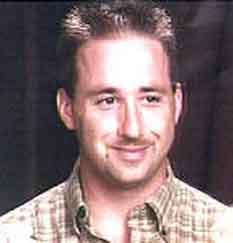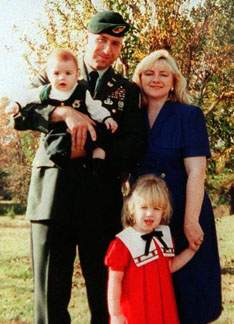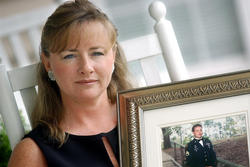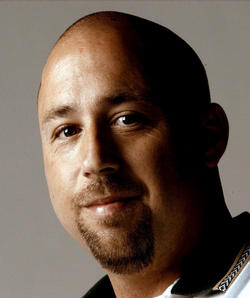RELEASED: March 4, 2002
DEPARTMENT OF DEFENSE IDENTIFIES SOLDIER KILLED IN ACTION
The Department of Defense announced today that Army Chief Warrant Officer Stanley L. Harriman, 34, of Wade, North Carolina, was killed in action in Afghanistan on Saturday, March 2, 2002, as the result of enemy fire. Harriman was assigned to the 3rd Special Forces Group at Fort Bragg, North Carolina.
The first casualty in the latest U.S. assault in Afghanistan had spent 16 years — his entire adult life — serving his country, his family said Monday.
Army Chief Warrant Officer Stanley L. Harriman, 34, was killed as a result gunfire from an Air Force AC-130 gunship that mistook his convoy for enemy forces. Saturday in a ground attack. On Monday, the Pentagon said seven more American soldiers were killed and 11 were wounded in the assault.

“He was so excited about being a part of it,” said Harriman’s wife, Sheila. “He loved not just being a soldier, but his country.”
Harriman, a native of Nixa, Mo., enlisted at the age of 18 and was stationed for 13 years at Fort Bragg, N.C., his wife said. The couple had two children.
“He died doing what he loved,” said Traci Lore, Harriman’s sister-in-law.
Harriman rarely talked about his career, said his cousin, Jeff Floyd.
“When he did speak about what he was doing, it was just about how he loved his job. Nothing about his details,” Floyd said. “That wasn’t him.”
Harriman’s twin brother was in the military, and they followed their father — who served in the Army — in military service.
Maj. Robert Gowan, a spokesman for the Special Operations Command at Fort Bragg, said little information could be released about Harriman and the circumstances of his death “because of ongoing operations” in Afghanistan.
The Pentagon said the seven soldiers who died Monday were killed when two U.S. helicopters took enemy fire during the most deadly allied air and ground offensive of the war in Afghanistan.
In the U.S. assault, code-named Operation Anaconda, Americans took the lead instead of relying on Afghan forces to take the fight to the al-Qaida.
March 12, 2003
Courtesy of CBS
These days, when the American military goes to war, it’s a pretty safe bet the United States will win.
But despite all the revolutionary advances brought about by precision-guided weapons, the U.S. has still not solved the age-old problem of fratricide – killing your own soldiers by mistake. CBS News National Security Correspondent David Martin reports for 60 Minutes II.
In the first Gulf War, one-fourth of the Americans killed in combat were killed by other Americans. And it happened again in Afghanistan – four Americans, four Canadians and 10 Afghan soldiers killed by friendly fire.
The biggest – and most costly – battle for American forces in Afghanistan was Operation Anaconda, the assault last March on al Qaeda’s last stronghold. Apache helicopters and other aircraft were providing cover for troops on the ground. Then the Apaches started taking hits, and so did the men on the ground.
“I was told initially that he was killed by (enemy) mortar fire,” says Sheila Harriman, whose husband, Stanley, was the first American killed in Operation Anaconda.
“His truck got hit in the front left side and he was the passenger in the front seat,” she continues. “The next hit came directly below my husband in his truck, and the shrapnel came up through the vehicle, so it went through his legs, his chest, his arms, severed a couple of his fingers, through his face, ripped most of his ear off, and up through the back of his head.”
He never had a chance.
“No, sir,” says Mrs. Harriman. “But he also didn’t feel any pain. That brings me comfort.”
Sheila Harriman’s pain was grotesquely compounded by what happened next.
“Until I got a knock on my door several weeks later,” she recalls, “I believed all the way up till then that my husband was killed by the enemy, by al Qaeda… The knock on the door was from News Channel 11 which is a local news station here. The gentleman on the other side of the door told me that it was released from the Pentagon, from General Franks, that my husband was…incident was being investigated for friendly fire. That was the first time I had even heard it.”
The Army did not tell her. A reporter did.
No matter who fired the fatal shot, Stanley Harriman is still a combat casualty, but to his widow, it makes all the difference.
“I was devastated,” she explains, “because the enemy was supposed to have killed my husband. That was a little different to swallow than thinking it was one of his own men, that it was an American that killed him.”
There were 28 friendly fire incidents in the first Gulf War. It is a sickening sight – American firepower killing American soldiers.
“Unfortunately, it gets very chaotic,” says retired General Gordon Sullivan. “People get scared, they’re tired, they’re wounded in some cases, they haven’t eaten for days, and stuff happens.”
Sullivan remembers how he found out “stuff” had happened in the first Gulf War. The Army had just fought and won a glorious victory, and Sullivan had sent a team to the desert to reconstruct the great tank battles of the war. But the report he got back was not so glorious.
“The gent who called me said, ‘Look, you’re probably not gonna like what we found, but here’s what we found.'”
They found that American weapons worked to perfection against the thick armor of the Iraqi tanks, but they also destroyed American armor. Three-fourths of the American tanks destroyed on the battlefield were hit by friendly fire.
“So,” says Sullivan, “essentially what we learned was: we, in fact, killed ourselves.”
A total of 35 Americans were killed by friendly fire in the Gulf War, and it didn’t end when the shooting stopped. Three years later, two Air Force jets patrolling Iraq’s northern no-fly zone mistook a pair of Black Hawk helicopters for Iraqi aircraft and shot them down — 15 more Americans killed by friendly fire.
Sullivan keeps a piece of parachute silk with the names of 44 men killed in action while he was Chief of Staff of the Army. Not all of them were victims of friendly fire, but some were.
“I think about those men every day. OK? There’s not one day I don’t think about them. And when I’m in this office, I’m standing over there on the phone, and they’re right beside me,” he says.
“Friendly fire is a term that’s always mystified me. It’s never friendly. You’re either killing the enemy or you’re killing your own soldiers, and there’s nothing friendly about it. It’s just a mistake,” says Major General Paul Eaton, who commands the infantry training school at Fort Benning, Georgia. He adds that friendly fire always comes back to the basics of combat.
He explains, “The three great questions on the battlefield have always been: ‘Where am I?’, ‘Where’s my buddy?’ and ‘Where’s the enemy?'”
But any soldier knows those questions are easier asked than answered in the heat of battle, particularly when, as in the Gulf War, American tanks, for all their fire and maneuver power, had no sure way of keeping track of each other.
Says Sullivan, “The only way you would know where the other tanks were is if you talked to them on a radio:
‘Well, where are you?’
‘I’m here. Where are you?’
And then somebody would say, ‘Well, I’m north of you.’
Yeah, well, that’s all interesting except, in the middle of the night, where’s north?”
The Army had to make its communications as accurate as its weapons. And so it developed a computer system to give every armored vehicle the same picture of the battlefield — blue for friendly, red for enemy.
Global position satellites track the blue friendly forces. As enemy tanks are spotted, their positions are plotted in red on the same screen. Any gunner logged onto the net can tell at a glance if it’s safe to open fire.
All very neat and tidy in a classroom, but will it really keep track of every piece of equipment – ours and theirs – in a full scale, full tilt invasion of Iraq? And will all the American vehicles even be equipped with that computer system?
Of the Army divisions today, how many of them have this capability?
Says Eaton, “It is proliferated throughout the Army.”
So any of the tanks, any of the infantry fighting vehicles that are over in Kuwait today, they will all have this system?
“We have applied this system to all units. That’s all I’m going to say,” Eaton replies.
In fact, the 4th Infantry Division, whose equipment is still stuck on ships waiting for approval to off load in Turkey, is the only division deployed for this coming war that has been completely equipped with the new technology.
The Army has rushed the system to the forces on the southern front in Kuwait but admits the distribution is – to use its word – thin, about one out of every 14 tanks. So, once again, it will come down to human beings calling the shots.
“Young guys out there, making decisions that save lives and cost lives,” says Sergeant Kenneth Killingsworth. “I mean, that’s war, and whoever makes sense out of all that chaos is gonna win.”
And, he adds, you have to be quick about it, because in ground combat, the one who shoots first usually wins.
As a practical matter, how long do they have to make that decision by the time you see an enemy?
“It could be anywhere from 9 seconds to 21 seconds,” Killingsworth replies.
The better you can see what you’re shooting at, the less likely you are to shoot one of your own men. The Bradley fighting vehicle has a thermal site which can give the gunner a very clear picture before he pulls the trigger. He should be able to see the piece of thermal tape on a soldier’s arm that identifies him (or her) as friendly.
The Army says the exact markings that will be used to identify American forces going into Iraq are secret, but insists every soldier who goes into combat will be wearing thermal tape and every armored vehicle will be fitted with thermal panels.
But those markings didn’t save Stanley Harriman.
Mrs. Harriman says, “I also spoke to the men that were on the ground with my husband. They said, ‘Yes, they were marked.’ Their persons were marked. Their vehicles were marked.”
According to the investigation into Harriman’s death, the AC-130’s computerized navigation system went down, and when the crew tried to find their way by using prominent landmarks on the ground, they got lost. When the gunship reported seeing a group of vehicles, no one realized it was Harriman and his men, even though they were wearing those friendly markings.
Not only that, Harriman was listening on the radio as the AC-130 zeroed in for the kill.
“He could hear the AC-130 describing what they saw, how many vehicles in the convoy,” says Mrs. Harriman, “and Stanley radioed over to the other ground controller: ‘You are describing us. You’re describing us.'”
Despite all that, the AC-130 was cleared to open fire. Every safeguard to protect friendly forces failed again, 12 years after the Army set out to solve the problem.
Concludes Sullivan, “Much as I’d like to say we can solve it, I don’t think we can solve it. I don’t think we can solve that 100 percent… This is a human endeavor. It is the most fundamental human endeavor. It’s dangerous. It’s serious business…This is serious business, serious business. And, by the way, say a prayer for the troops.”
First Soldier Killed in Afghanistan to Be Buried in Arlington
The family of the first soldier killed four years ago in the war on terror is preparing for his
burial at Arlington National Cemetery
29 March 2006
Friendly fire killed Chief Warrant Officer Stanley Harriman during Operation Anaconda in Afghanistan. While his remains returned to the U.S. just days after his death, his family did not decide on a final resting place until recently.
Since Harriman’s death, there have been a number of memorial services honoring him. But his wife, Sheila, says he will be interred at Arlington.
“We went to go see Faces of the Fallen last summer. They had featured Stanley in there. They had the portrait done of him,” Sheila Harriman said. “While we were walking Arlington and it just answered my question. This is where he needs to be.”
After Stanley Harriman died, Sheila had him cremated. His ashes have been at her home for the past four years.
“I think having him in his urn for four years here at the house has left the books so open that we need another step toward healing. Another step of closure,” she said.
The ceremony at Arlington takes place the afternoon of April 13, 2006. Sheila Harriman says it will be an emotional celebration of her husband’s life and one to which she is extending an open invitation.
“There have been so many people over these last four years that loved us, cared for us, prayed for us, been there for us, thought of us that I don’t want to miss anybody to give them the opportunity to come,” she said. “This is our way of saying thank you. Thank you for caring for us all these years.”
Chief Warrant Officer Stanley L. Harriman is shown with his Wife, Sheila Harriman Children, Darbi Harriman, now 6, and Christopher Harriman, now 3, in this undated family photo
Tournament honors soldier
By Robert Winterode
Sheila Harriman holds a picture of her late husband, Staff Sgt. Stan Harriman, who was killed in Afghanistan by friendly fire.
It was the second day of Operation Anaconda in Afghanistan, and the troops quickly confronted death.
“It was a very emotional day for us,” said Chris, a Special Forces officer who asked that his last name not be published because of field security concerns. “Our team was the first team from Third Group to be doing unconventional warfare since Vietnam.”
Unconventional warfare meant leading a group of indigenous soldiers into combat against the enemy.
On March 2, 2002, the operation’s first casualty didn’t come by way of the enemy.
On the road from Gardez to the Shahi Kot Valley, an AC-130 gunship mistakenly fired at what it believed to be an enemy convoy. It was Stanley Harriman’s convoy that he was leading through a mountain pass — what they call a choke point — to rout renegade Taliban. Two soldiers were wounded and Harriman was killed.
It was Harriman’s 16th year in the Army. He was 34. That April 13, he was buried in Arlington National Cemetery in Arlington, Va. The Army awarded the warrant officer several posthumous medals — a Silver Star for valor, a Purple Heart for wounds received in combat and a Combat Infantryman’s Badge.
Years earlier, he had served in the Persian Gulf War.
Years later, he will be memorialized with the fifth annual Stanley L. Harriman Memorial Golf Tournament, scheduled for for June 10 at Baywood Country Club.
The tournaments beneficiary, The Stan the Man Foundation, was conceived by Steve Harriman three months after his twin brother’s death as an outreach organization to the military and their families.
The tournament’s grounding in recreational golf is itself bittersweet; years ago, Stan taught Steve how to putt.
“He’s the one who got me hooked on golf,” Steve said.
About the foundation, he said, “This could be my therapy, my way of keeping him close to me.”
The nonprofit has raised almost $100,000. Shipping quality-of-life items such as razors and toothpaste to overseas military and adopting military families in need during the holiday season are some ways the foundation reaches out. The first scholarship given in Stan’s name will be awarded this year.
The foundation’s logo is a symbol summing up who Steve’s brother was: “a green beret with a heart of gold.”
“He would’ve given the shirt off his back to help somebody,” Steve said. “He’d be one of those guys in a drive-through getting something to eat and he’d pay for himself and the person in back of him, too.”
Stan’s wife, Sheila, echoed that. After Sept. 11, 2001, when security was increased on Fort Bragg and checkpoints were set up, Stan and his family stopped at the Scotchman store on Yadkin Road, buying a quantity of Gatorade in bottles. Sheila, who is on the foundation’s scholarship committee, assumed the drinks were for their kids.
“We go through checkpoint, and he starts to hand out Gatorade to the guys who were standing out there,” she said.
The Harriman twins and another brother enlisted in the Army as an homage of sorts to their father, a retired Army major who piloted helicopters.
Steve got out after about five years. His brother, the careerist, stayed.
“He had it all figured out,” Steve said. “He wanted to be a teacher when he got out.”
According to his brother, Stan would’ve taught body shop or carpentry.
“He was a very hands-on type guy,” Steve said.
A combat engineer in the Army, Stan used to build structures of another kind abroad: bridges that could be blown up after use.
Chris served with Stan for nine months as a medic in both Nigeria and Afghanistan.
Stan was one to take in the rays. Chris remembered giving him a dose of the antimalarial medication, doxycycline and warning him that the medicine required limited sun exposure of the patient.
That didn’t stop Stan. Hours later, Chris came upon him risking a painful case of sunburn and “sunning himself in nothing but a pair of black shorts.”
“He had this pair of overalls that he made into shorts,” Steve said. “That’s how he was happiest, when he was wearing those overalls and working outside. He’d love to be outside in the sun.”
Steve’s daughter now wears the overalls to the tournament every year as a tribute to her uncle.
Michael Robert Patterson was born in Arlington and is the son of a former officer of the US Army. So it was no wonder that sooner or later his interests drew him to American history and especially to American military history. Many of his articles can be found on renowned portals like the New York Times, Washingtonpost or Wikipedia.
Reviewed by: Michael Howard



